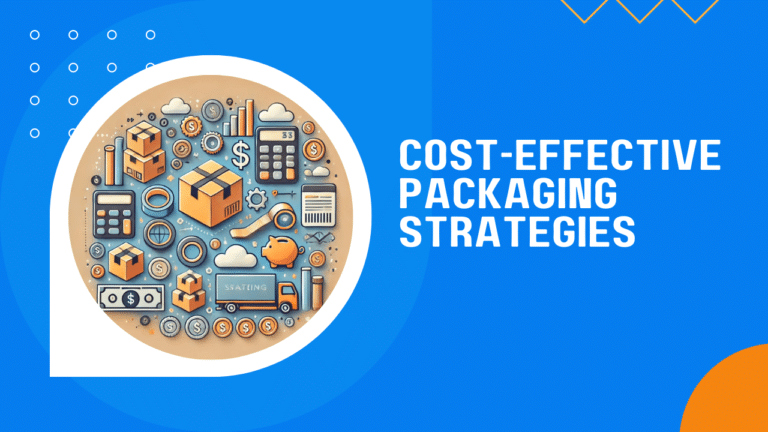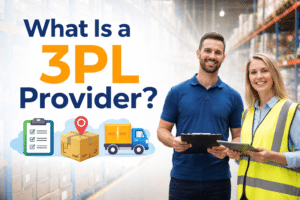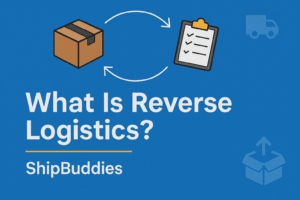Packaging is a vital component in balancing profitability and customer satisfaction for ecommerce businesses. Adopting cost-effective packaging strategies allows companies to reduce expenses without compromising product safety, sustainability, or brand image.
Optimizing packaging goes beyond cost reduction; it enhances the customer experience and supports a brand’s commitment to efficiency and environmental responsibility.
This article provides actionable strategies to help ecommerce businesses select the right materials, refine packaging design, and leverage technology to achieve significant cost savings.
Key Principles of Cost-Effective Packaging
Ecommerce businesses can achieve significant cost savings and operational efficiency by adhering to key principles of cost-effective packaging. These principles not only reduce expenses but also enhance sustainability and customer satisfaction. The two most impactful strategies involve right-sizing packages and using lightweight yet durable materials.
Right-Sizing Packages
Right-sizing packages refers to the practice of selecting packaging that closely matches the dimensions of the product, thereby minimizing unused space. This strategy is crucial for reducing both material costs and shipping expenses. In ecommerce, where shipping fees are often calculated based on dimensional weight, excessive packaging can lead to higher costs. By optimizing the size of the packaging, businesses can avoid paying for unnecessary bulk and reduce their environmental impact.
Right-sizing also plays a significant role in improving the customer experience. Overly large or ill-fitting packages can lead to damaged products, which in turn increases the likelihood of returns and negatively affects customer satisfaction. Additionally, consumers are increasingly eco-conscious and appreciate brands that avoid excessive packaging. Adopting right-sizing can thus enhance brand perception while cutting costs. For example, using custom-sized boxes instead of standard sizes ensures that each product is securely packaged without excess material, resulting in fewer damages during transit and lower shipping fees.
Lightweight and Durable Materials
The selection of lightweight and durable materials is another critical factor in cost-effective packaging. Materials that offer high strength-to-weight ratios, such as corrugated cardboard, molded pulp, or thin but resilient plastics, help reduce shipping costs by lowering the overall weight of the package. These materials must provide sufficient protection to prevent damage during shipping, which is particularly important for ecommerce businesses that rely on logistics networks where packages may endure rough handling.
Lightweight materials can also be sustainable. For instance, corrugated cardboard is not only strong and lightweight but also recyclable, making it a popular choice for businesses aiming to reduce their environmental footprint. By using materials that are both durable and environmentally friendly, ecommerce companies can appeal to eco-conscious consumers who value sustainable practices. Additionally, durable materials reduce the risk of product damage, leading to fewer returns, which further contributes to cost savings.
Moreover, investing in innovative materials such as biodegradable plastics or plant-based packaging can provide long-term savings. These materials may have a higher upfront cost but offer significant benefits in terms of brand reputation and customer loyalty. As consumers increasingly demand eco-friendly options, businesses that prioritize sustainability in their packaging materials can differentiate themselves in a crowded market.
Innovative Packaging Strategies
To stay competitive and cost-efficient, ecommerce businesses must continually innovate their packaging strategies. Adopting custom-sized packaging, reducing material usage, and integrating sustainability practices are key approaches that not only cut costs but also enhance product security, brand appeal, and environmental responsibility.
Custom-Sized Packaging
Custom-sized packaging allows ecommerce businesses to tailor the dimensions of packaging to fit each product precisely. Unlike standard packaging, which can lead to wasted space and increased shipping costs, custom packaging minimizes empty space, reducing the need for filler materials and lowering dimensional weight charges. This approach not only saves money but also offers a better unboxing experience, enhancing customer satisfaction.
Moreover, custom packaging can be designed to reflect a brand’s identity, creating a more memorable impression on customers. For example, a business selling luxury goods might invest in custom packaging that adds a premium feel, reinforcing the product’s value. On the other hand, a company focused on sustainability might use custom-sized boxes made from eco-friendly materials, emphasizing their commitment to the environment.
Reducing Material Usage
Reducing the amount of material used in packaging is a straightforward way to lower costs and improve sustainability. Design innovations such as foldable boxes, interlocking pieces, or multi-use packaging reduce the amount of material required without compromising product protection. For instance, foldable boxes can be shipped flat to save space and then assembled easily, cutting down on storage and shipping expenses.
Additionally, businesses can explore using thinner but stronger materials or combining multiple functions into a single packaging component. For example, a box could be designed to double as a return shipping container, eliminating the need for extra packaging. These innovations reduce material waste, lower costs, and support a more sustainable supply chain.
Sustainability Practices
Incorporating sustainability practices into packaging design not only reduces long-term costs but also aligns with growing consumer demand for eco-friendly products. Using recyclable, biodegradable, or compostable materials helps businesses reduce their environmental impact and appeal to environmentally conscious customers. Sustainable packaging options, such as kraft paper, plant-based plastics, or water-based inks, are increasingly available and cost-effective, making them practical choices for ecommerce businesses.
Furthermore, sustainability can extend beyond materials to include packaging processes. For example, using fewer colors in printing, or opting for minimalistic designs, can reduce ink usage and energy consumption, further lowering costs. Some businesses also adopt a circular economy approach by encouraging customers to return packaging for reuse or recycling, creating a closed-loop system that reduces waste.
These innovative packaging strategies not only drive cost-efficiency but also enhance brand reputation and customer loyalty. As ecommerce businesses increasingly prioritize sustainability and operational efficiency, these approaches will continue to play a vital role in their success.
While these innovative strategies provide substantial benefits, the next step in optimizing packaging lies in the integration of technology and automation. In Section 3, we will explore how ecommerce businesses can leverage automated packaging solutions and advanced technology to further streamline processes, reduce costs, and enhance overall efficiency.
Leveraging Technology and Automation
As ecommerce businesses scale, the complexity of their packaging operations increases, making it essential to integrate technology and automation. By adopting automated packaging solutions and leveraging advanced technology integration, companies can streamline processes, reduce costs, and ensure optimal packaging for every product.
Automated Packaging Solutions
Automated packaging solutions involve using machinery and robotics to handle tasks traditionally performed by human workers, such as boxing, sealing, and labeling. Automation not only speeds up the packaging process but also enhances accuracy and consistency. For example, automated box-making machines can create custom-sized boxes on demand, reducing material waste and eliminating the need for a variety of pre-made box sizes.
Additionally, automation can significantly lower labor costs. With machines handling repetitive tasks, businesses can reallocate their workforce to more strategic roles, improving overall productivity. Automated systems also reduce the likelihood of human error, leading to fewer packaging mistakes, such as incorrect labeling or improper sealing, which can otherwise result in costly returns and damaged products.
Technology Integration
Technology integration in packaging involves using advanced tools such as dimensioning systems, packaging management software, and data analytics to optimize operations. Dimensioning systems automatically measure the size and weight of products, ensuring the use of the most cost-effective packaging. This technology reduces the guesswork involved in selecting packaging, leading to lower shipping costs and improved efficiency.
Packaging management software can streamline the entire packaging process, from inventory management to shipping. For example, software that integrates with an ecommerce platform can automatically determine the best packaging option based on the product’s dimensions and weight, reducing the time spent on manual decisions. Furthermore, data analytics tools can track packaging performance, identify inefficiencies, and provide insights into areas for improvement, such as material usage or shipping costs.
The Benefits of a Technological Approach
Combining automation with advanced technology offers ecommerce businesses several benefits. First, it allows for scalable solutions that can grow with the business, accommodating higher order volumes without compromising speed or accuracy. Second, it provides the flexibility to adapt packaging strategies in real-time based on changing needs or market conditions. Lastly, it ensures that every product is packaged in the most cost-effective and protective manner, reducing waste and maximizing profit.
As technology continues to evolve, the opportunities for optimizing ecommerce packaging through automation and integration will only increase. By staying ahead of the curve and investing in these technologies, businesses can achieve long-term cost savings and operational efficiency.
While technology and automation offer powerful tools for packaging optimization, another crucial aspect of cost-effective packaging lies in strategic procurement.
Bulk Purchasing and Supplier Relationships
Strategic procurement is a cornerstone of cost-effective packaging in ecommerce. By purchasing packaging materials in bulk and cultivating strong supplier relationships, businesses can achieve significant cost reductions and gain access to innovative packaging solutions that enhance efficiency and sustainability.
Bulk Purchasing
Bulk purchasing involves buying large quantities of packaging materials at once, which typically results in lower per-unit costs. This approach is particularly beneficial for high-volume ecommerce businesses that require consistent packaging supplies. By ordering in bulk, companies can take advantage of discounts, reduce the frequency of reordering, and ensure a steady supply of materials, thereby avoiding potential disruptions that could delay order fulfillment.
However, bulk purchasing requires careful planning and storage management. Businesses must assess their packaging needs accurately to avoid overstocking, which can tie up capital and require additional storage space. To mitigate these risks, companies can use demand forecasting tools that predict future packaging needs based on sales trends, ensuring that they order the right amount at the right time.
Supplier Partnerships
Building strong supplier relationships is equally important for cost-effective packaging. A reliable supplier can offer more than just competitive pricing; they can provide valuable insights into new materials, technologies, and industry trends that can further optimize packaging operations. For example, a supplier might introduce a new, eco-friendly material that aligns with a company’s sustainability goals while also reducing costs.
Moreover, businesses with strong supplier partnerships can often negotiate favorable terms, such as flexible payment options, shorter lead times, or customized packaging solutions. These partnerships foster collaboration, allowing suppliers to better understand the unique needs of the business and tailor their offerings accordingly. In turn, this can lead to innovations in packaging design, material usage, and process improvements that further enhance cost efficiency.
Collaborating for Innovation
Supplier relationships are also critical for driving packaging innovation. Collaborative partnerships can lead to the co-development of custom packaging solutions that are both cost-effective and tailored to the specific needs of the business. For example, a supplier might work with an ecommerce company to develop a new packaging design that reduces material usage while still providing adequate protection for products during transit. Such innovations can set a business apart from competitors by improving both cost efficiency and customer satisfaction.
Effective collaboration with suppliers can also lead to sustainable packaging solutions. By working together, businesses and suppliers can identify eco-friendly materials and processes that reduce environmental impact without increasing costs. This not only appeals to environmentally conscious consumers but also strengthens the brand’s reputation in a market where sustainability is increasingly valued.
With bulk purchasing and strong supplier relationships in place, ecommerce businesses can significantly reduce their packaging costs while ensuring a steady supply of materials and access to cutting-edge innovations. These strategies are essential for maintaining cost-effective packaging in a rapidly evolving industry.
Packing It All Up
Cost-effective packaging strategies are essential for ecommerce businesses aiming to maximize profit while minimizing waste. By focusing on key principles such as right-sizing packages and using lightweight, durable materials, companies can achieve significant cost savings without compromising product protection. Innovative approaches like custom-sized packaging, reducing material usage, and integrating sustainability practices not only reduce costs but also enhance brand reputation and customer satisfaction.
Leveraging technology and automation further streamlines packaging processes, leading to improved efficiency and reduced labor costs. Additionally, strategic procurement through bulk purchasing and strong supplier relationships ensures consistent access to cost-effective and innovative packaging solutions. Real-world case studies have shown that businesses that adopt these strategies not only cut costs but also strengthen their market position and appeal to increasingly eco-conscious consumers.
As ecommerce continues to grow, the importance of packaging optimization will only increase. By implementing these cost-effective strategies, businesses can enhance their operational efficiency, reduce their environmental impact, and deliver a superior customer experience—ultimately driving long-term success.







